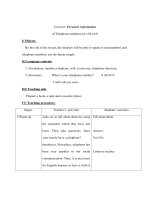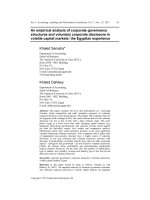Online privacy and personal information disclosure
Bạn đang xem bản rút gọn của tài liệu. Xem và tải ngay bản đầy đủ của tài liệu tại đây (3.19 MB, 168 trang )
FACEBOOK
AND
YOUTH@SG:
ONLINE
PRIVACY
AND
PERSONAL
INFORMATION
DISCLOSURE
OU
MEIMIN
NATIONAL
UNIVERSITY
OF
SINGAPORE
2010
AND
YOUTH@SG:
ONLINE
PRIVACY
AND
PERSONAL
INFORMATION
DISCLOSURE
OU
MEIMIN
(B.
Soc
Sc,
Hons.,
Minor
in
Technopreneurship),
NUS
A
THESIS
SUBMITTED
FOR
THE
DEGREE
OF
MASTERS
IN
ARTS
COMMUNICATIONS
AND
NEW
MEDIA
PROGRAMME
NATIONAL
UNIVERSITY
OF
SINGAPORE
2010
2
Acknowledgements
It
is
with
a
humble
heart
that
I
thank
the
many
people
in
my
life
who
made
this
thesis
possible.
Many
people
have
been
part
of
my
path
in
graduate
school,
as
friends,
teachers,
mentors
and
supporters.
Dr
Lim
Sun
Sun
has
played
an
instrumental
role
in
my
thesis
endeavor.
I
have
learnt
a
lot
from
her
succinct
method
of
instruction.
She
has
allowed
me
to
learn
independently
as
a
budding
scholar
in
communications.
Her
expert
grasp
of
existing
concepts
benefitted
me
as
I
experimented
with
different
areas
before
deciding
on
social
media,
privacy
and
youths.
Other
mentors
in
the
Communications
and
New
Media
programme
include
Dr
“Millie”
Rivera,
who
convinced
me
to
return
to
pursue
my
graduate
degree.
Her
mentorship
and
advice
have
been
invaluable.
My
gratitude
is
also
extended
to
Dr
Cho
HiChang,
whose
support
and
patience
allowed
me
to
learn
a
lot
under
his
tutelage.
I
am
thankful
to
have
completed
this
graduate
course
with
the
support
from
the
programme
and
I
have
brought
away
from
my
graduate
education
not
just
technical
and
theoretical
knowledge,
but
precious
life
lessons
as
well.
My
gratitude
also
extends
to
my
fellow
colleagues
and
graduate
students:
Ms
Gene
Van
Heerden
and
Mr
Gui
Kai
Chong,
esteemed
colleagues
whom
I
have
worked
with
and
developed
respect
for;
office-‐mates
Aaron,
Aru,
Charlene,
Li
Ting,
Jodie,
Joshua,
Elmie,
Siti
and
Yoke
Hian,
who
brighten
up
my
days
at
work;
and
fellow
grad
students
Carol,
Ganga,
Wang
Rong
and
Cathy,
who
make
graduate
classes
both
fun
and
intellectually
stimulating.
The
CNM
administrative
staff
Retna
and
Adeline
have
provided
support
throughout
my
graduate
education
and
deserve
acknowledgement
for
their
daily
efforts.
I
am
grateful
to
have
had
the
ever-‐present
support
of
family
and
friends
while
completing
graduate
school.
To
Clare,
Shuting,
Alice,
Yanni
and
Li
Ting,
who
lent
a
listening
ear
to
my
ideas
and
volunteered
their
help
for
my
thesis
data
collection,
I
thank
you
for
your
time
and
help.
To
my
“Fab
Five”,
Ange,
Viv,
Steph
and
JW,
our
meet
ups
provided
me
with
the
respite
needed
to
continue
with
my
writing
and
grading.
Your
boundless
hospitality
and
homemade
hearty
fare
never
fail
to
recharge
me
to
handle
the
challenges
that
came
along.
Special
mentions
include
Siti,
Clare
and
Yanni,
who
have
gone
out
of
their
way
to
help
me
make
completing
this
thesis
a
reality.
Words
alone
cannot
express
my
gratitude
for
your
help,
support
and
encouragement
throughout
this
process.
Last
but
not
least,
to
my
parents,
David
Ow
and
Serena
Tan,
and
to
my
grandparents,
I
dedicate
this
thesis
to
you,
for
all
your
prayers,
unwavering
love
and
support
through
my
all
nighters
and
balancing
of
work
and
studies.
3
Table
of
Contents
Summary ................................................................................................................................................ 6
List
of
Tables......................................................................................................................................... 7
List
of
Figures....................................................................................................................................... 8
Chapter
1:
Introduction ................................................................................................................... 9
1.1
Introduction .................................................................................................................................. 9
1.2
Background
information:
What
is
a
Social
Network
Site
(SNS)? .........................15
1.3
Basic
features
of
SNS ...............................................................................................................17
1.4
World-‐wide
SNS
phenomenon
and
the
rise
of
Facebook ....................................... 19
1.5
Background
of
Facebook .......................................................................................................19
1.5.1
features ................................................................................................................ 21
1.5.2
What
sets
apart
from
other
SNS................................................................ 22
1.6
Popular
online
social
networking
websites
in
Singapore .......................................22
Chapter
2:
Literature
review
on
youths
and
their
online
culture .............................. 23
2.1
Youths ........................................................................................................................................... 23
2.1.1
The
idea
of
a
generation.................................................................................................... 23
2.1.2
Identity
formation
and
negotiation.............................................................................. 25
2.2
Concerns
about
youth
online.............................................................................................. 29
2.2.1
Online
sexual
solicitations................................................................................................ 31
2.2.2
Internet
and
health-‐related
problems......................................................................... 32
Chapter
3:
Literature
review
on
SNS ...................................................................................... 33
3.1
SNS
research
to
date............................................................................................................... 33
3.1.1
Virtual
communities
and
the
network
effect............................................................ 36
3.1.2
Community,
culture
and
civic
engagement............................................................... 36
3.1.3
Social
Capital .......................................................................................................................... 37
3.1.4
Identity,
self-‐presentation
and
contextualizing
in
SNS........................................ 38
3.2
Framing
policy-‐relevant
research .................................................................................... 42
Chapter
4:
Social
network
theory,
privacy
and
information
disclosure.................. 44
4.1
Concept
of
privacy ....................................................................................................................44
4.2
Social
network
theory
and
privacy ...................................................................................47
4.3
Online
information
disclosure
and
privacy ...................................................................48
4.4
SNS
and
privacy .........................................................................................................................51
4.4.1
SNS
privacy
policies
and
settings ............................................................ 53
4.5
Parents
and
online
privacy ...................................................................................................54
4.6
Youths
and
online
privacy.....................................................................................................55
4.7
Research
Questions..................................................................................................................56
Chapter
5:
Methodology ............................................................................................................... 57
5.1
Selecting
research
methods..................................................................................................57
5.1.3
Content
analysis.................................................................................................................... 61
4
5.1.4
Surveys...................................................................................................................................... 61
5.1.5
Benefits
of
mixed
methods
research............................................................................ 63
5.2
Research
Design ....................................................................................................................... 64
5.2.1
Content
analysis.................................................................................................................... 66
5.2.1.1
Coding
frame ...................................................................................................................... 66
5.2.1.2
Sampling ............................................................................................................................... 68
5.2.2
Surveys...................................................................................................................................... 74
5.2.2.1
Survey
format
and
questions....................................................................................... 75
5.2.2.2
Dimensions.......................................................................................................................... 79
5.2.2.3
Sampling ............................................................................................................................... 83
5.3
Challenges
encountered
in
the
course
of
data
collection ....................................... 87
5.3.1
Challenges
faced
at
the
conceptualization
phase ................................................... 87
5.3.2
Challenges
faced
at
the
implementation
phase....................................................... 87
Chapter
6:
Findings
and
discussion
–
Content
analysis.................................................. 88
6.1
Overview
of
chapter................................................................................................................ 88
6.2
Representativeness
of
student
profiles
and
data
storage ...................................... 89
6.3
Addressing
the
research
questions.................................................................................. 90
6.3
Observations
from
the
content
analysis
of
Singaporean
youths’
profiles ................................................................................................................................................. 99
6.3.1
Number
of
friends
on
Facebook..................................................................................... 99
6.3.2
Youths’
different
approaches
to
information
privacy ...................100
6.4
Contribution
to
existing
literature .................................................................................103
6.4.1
SNS
and
youths....................................................................................................................103
6.4.2
Level
of
information
disclosure
in
SNS.....................................................................104
6.4.3
Virtual
communities
and
network
effect .................................................................105
6.4.4
Identity,
self-‐presentation
and
contextualizing
in
SNS......................................106
6.4.5
Privacy,
surveillance
and
legal
issues........................................................................108
6.5
Laying
groundwork
for
online
surveys ........................................................................108
Chapter
7:
Findings
and
discussion
–
Online
Surveys...................................................109
7.1
Overview
of
chapter..............................................................................................................109
7.2
Representativeness
of
survey
participants
and
data
storage.............................110
7.4
Discussion
from
findings
of
online
surveys................................................................130
7.4.1
Youths’
self-‐assessment
of
Facebook’s
privacy
safeguards.............................130
7.5
Contribution
of
study
to
current
literature ................................................................135
7.5.1
Negotiation
and
management
of
identity
in
Facebook......................................135
7.5.2
Parental
concerns
and
Facebook.................................................................................135
7.5.3
Policy
and
Facebook..........................................................................................................137
Chapter
8:
Conclusion..................................................................................................................139
8.1
Summary
of
findings.............................................................................................................139
8.2
Limitations
of
study ..............................................................................................................141
8.3
Implications
of
study
on
policy-‐making.......................................................................142
8.4
Suggestions
for
future
research.......................................................................................144
Bibliography ....................................................................................................................................146
Appendices .......................................................................................................................................165
5
Summary
With
the
proliferation
of
social
networking
sites
(SNS)
such
as
gaining
a
foothold
in
Singaporean
youths’
daily
lives,
Singaporean
parents
and
educators
are
seeking
to
better
understand
the
different
facets
of
social
interaction
in
SNS.
In
particular,
the
issue
of
youths’
safety
online
has
been
of
interest
to
parents,
policymakers
and
educators.
For
the
purpose
of
this
study,
research
questions
revolve
around
two
pertinent
issues
of
concern
regarding
Singaporean
youths’
usage
of
Facebook,
currently
Singapore’s
most
popular
SNS.
I
seek
to
understand:
i)
whether
youths
are
utilizing
Facebook’s
privacy
safeguards,
and
ii) the
extent
and
nature
of
personal
information
revealed
in
their
profiles.
Understanding
youths’
privacy
perceptions
based
on
their
privacy
safeguards
and
level
of
personal
information
in
Facebook,
as
well
as
Singaporean
parents’
online
privacy
perceptions
and
knowledge
of
their
children’s
levels
of
information
disclosure
in
can
aid
in
ascertaining
if
there
exists
a
difference
in
attitudes
towards
online
privacy
and
personal
information
disclosure
between
Singaporean
parents
and
youths.
Ascertaining
this
will
in
turn
aid
in
bridging
the
differences
in
perceptions,
if
any,
between
parents
and
their
teenage
children,
thus
facilitating
discussions
when
parents
guide
their
teenage
children
in
online
safety.
Results
from
the
study
will
also
provide
valuable
input
when
formulating
policies
and
planning
online
safety
campaigns.
Results
from
the
two-‐pronged
approach
of
content
analysis
and
online
surveys
indicate
that
Singaporean
parents
are
generally
aware
of
their
teenage
children’s
habits
and
level
of
personal
information
disclosure.
Both
Singaporean
parents
and
youths
are
privacy-‐oriented,
but
youths
are
willing
to
compromise
some
privacy
in
order
to
allow
their
peers
understand
them
better
via
Facebook.
Youths
are
aware
and
do
utilize
Facebook’s
privacy
safeguards
but
there
exists
a
disparity
between
what
they
think
they
know
and
what
they
actually
know
about
the
privacy
settings
which
should
be
noted.
In
terms
of
the
extent
and
level
of
personal
information
disclosure,
Singaporean
youths
reveal
more
personal
information
in
their
public
profiles
than
private
profiles.
However,
they
are
also
more
discerning
about
the
types
of
personal
information
they
reveal
in
and
utilize
creative
methods
to
mask
their
personal
information.
My
findings
indicate
that
there
is
no
great
disparity
in
privacy
perceptions
between
Singaporean
parents
and
youths
and
that
there
is
already
ongoing
dialogue
between
parents
and
youths
online
safety.
This
creates
a
conducive
environment
for
parents
to
discuss
with
their
youths
about
online
safety
without
intruding
into
youths’
practices
of
identity
management
in
Facebook.
6
List
of
Tables
a) Table
6.1:
Types
of
profiles
and
personal
information
revealed
b) Table
6.2:
Identifiers
in
youths’
profiles
c) Table
7.1:
Types
of
information
Singaporean
youths
post
in
d) Table
7.2:
Privacy
values
attached
to
types
of
personal
information
in
e) Table
7.3:
Veracity
of
personal
information
that
Singaporean
youths
post
on
f) Table
7.4:
Topics
about
online
safety
that
parents
discuss
with
their
teenagers
g) Table
7.5:
Steps
taken
by
parents
to
enhance
their
teenagers’
online
safety
h) Table
7.6:
Parents’
impression
of
their
teenage
children’s
usage
i) Table
7.7:
Youths’
usage
j) Table
7.8:
Types
of
information
parents
think
their
teenage
children
post
in
k) Table
7.9:
Parents’
most
frequent
sources
of
information
for
online
safety
l) Table
7.10:
Parental
concerns
about
teenage
children’s
online
social
interactions
m) Table
7.11:
Parents’
perceptions
of
how
aids
in
teenage
children’s
development
n) Table
7.12:
Privacy
perceptions
of
youths
o) Table
7.13:
Privacy
perceptions
of
parents
and
youths
–
Independent-‐samples
t
Test
p) Table
7.14:
Privacy
perceptions
of
parents
and
youths
–
Independent-‐samples
t
Test
q) Table
7.15:
Privacy
perceptions
of
parents
and
youths
–
Independent-‐samples
t
Test
r) Table
7.16:
Cronbach’s
alpha
for
Westin
privacy
segmentation
dimensions
s) Table
7.17:
Reliability
statistics
for
Westin
privacy
segmentation
dimensions
–
youths
t) Table
7.18:
Percentage
of
youths
who
are
Privacy
Fundamentalists/Pragmatists/Unconcerneds
u) Table
7.19:
Percentage
of
parents
who
are
Privacy
Fundamentalists/Pragmatists/Unconcerneds
v) Table
7.20:
Comparison
of
privacy
perception
means
across
gender
for
parents
and
youths
w) Table
7.21:
Percentage
of
youths
who
are
aware
of
the
various
privacy
safeguards
x) Table
7.22:
Percentage
of
youths
who
utilize
the
various
privacy
safeguards
7
List
of
Figures
a) Fig
5.1:
Facebook’s
search
engine
b) Fig
5.2:
Friends
list
of
a
student
c) Fig
5.3:
A
Secondary
school’s
page
d) Fig
5.4:
Example
of
posts
in
discussion
boards
to
get
students
for
online
survey
e) Fig
6.1:
An
example
of
a
public
profile
f) Fig.
6.2:
A
profile
with
conflicting
personal
information
g) Fig.
6.3:
An
example
of
a
private
profile
with
minimal
personal
information
h) Fig.
6.4:
An
example
of
a
private
profile
revealing
more
personal
information
i) Fig.
6.5:
An
example
of
a
private
profile
under
a
moniker
j) Fig.
6.6:
An
example
of
a
youth’s
profile
under
a
moniker-‐real
name
k) Fig.
6.7:
Another
example
of
a
youth
and
her
friends
who
adopt
moniker-‐real
names
l) Fig.
6.8:
An
example
of
a
profile
under
a
colloquial
moniker,
“Gabie
Suaku”
m) Fig.
6.9:
A
Singaporean
youth’s
profile
photo
displaying
her
social
and
school
affiliations
n) Fig
6.10:
A
Singaporean
youth’s
profile
photo
emphasizing
on
achievements
in
school
o) Fig
6:11:
Singaporean
youth’s
profile
where
youth
has
parents
as
friends
on
p) Fig
6.12:
A
profile
photo
of
a
group
that
belongs
to
the
same
demographic
group
q) Fig
6.13:
A
profile
photo
of
two
groups
of
Singaporean
youths
that
belong
to
the
same
demographic
group
8
Chapter
1:
Introduction
1.1
Introduction
With
the
advent
of
Web
2.0,
we
see
a
tremendous
increase
in
social
media
usage.
The
rise
of
blogs
and
other
user-‐generated
content
outlets
such
as
Youtube
for
videos
and
Flickr
for
photos
have
been
gaining
popularity
not
only
because
they
allow
for
users
to
create
and
upload
their
work,
but
also
because
they
provide
the
option
to
share
their
content
with
others.
This
has
contributed
to
the
internet
being
used
in
an
increasingly
social
manner.
Interactivity
and
inter-‐
connectedness
are
synonymous
with
the
most
popular
activities
online
today.
One
of
the
most
frequently
used
social
media
these
days
is
social
networking
sites
(SNS).
While
the
term
used
to
include
blogs,
video
and
photo
sharing
websites;
SNS
today
usually
refer
to
websites
such
as
MySpace,
Multiply,
Friendster,
Orkut,
and
Facebook.
Such
websites
have
elements
of
blogging,
video
and
photo
sharing
embedded
within
them
though
their
main
feature
is
to
explicate
one’s
social
network
and
displaying
links
between
users.
While
terms
such
as
“poking”,
“throwing
sheep”
and
having
virtual
food
fights
might
have
drawn
perplexed
responses
two
years
ago,
these
terms
have
become
part
of
the
daily
activities
conducted
in
popular
SNS
today.
The
feverish
popularity
of
such
websites
has
no
doubt
piqued
the
curiosity
and
interest
of
many
students
as
well
as
young
working
professionals.
“Poking”
and
“throwing
sheep”
are
just
some
of
the
many
activities
one
can
engage
in
Facebook,
9
currently
one
of
the
most
popular
SNS
used
to
socialize
with
both
family
and
friends,
expanding
and
organizing
existing
offline
social
connections
while
building
new
ones.
Besides
allowing
for
communication
among
the
ever-‐widening
circles
of
both
youths
and
adults,
another
draw
of
SNS
is
how
they
allow
for
the
convergence
of
different
online
tools:
emailing,
messaging,
website
creation
and
customization,
dairies,
photo
albums,
music
or
video
uploading
and
downloading.
Technology
has
become
a
platform
where
different
types
of
applications
can
be
used,
for
the
same
purpose
of
socializing.
SNS
do
not
come
with
a
prescribed
way
of
using
the
technology,
but
rather,
permit
customization,
depending
on
the
preferences
of
the
users.
This
has
allowed
for
users
to
explore
the
affordances
of
SNS,
to
pick
and
choose
which
tools
to
use
for
socialization.
This
has
also
resulted
in
a
new
set
of
online
demographics,
where
people
from
the
same
demographic
group
offline
may
use
SNS
differently,
based
on
their
interests
and
preferences.
The
rise
of
SNS
has
drawn
the
attention
of
not
just
media
scholars,
but
also
the
media,
as
seen
from
the
increasing
coverage
of
the
SNS
phenomena
in
newspapers.
Advertisers
and
businesses
are
also
interested
to
see
how
they
can
leverage
on
SNS
to
get
their
messages
out
to
their
target
markets
in
a
manner
that
is
most
accessible
to
their
consumers.
Educators
are
interested
in
whether
they
can
incorporate
SNS
in
their
syllabus
to
capture
their
students’
attention
and
sustaining
their
interest
while
carrying
out
classes
effectively.
Even
political
10
figures
are
creating
a
presence
in
SNS
so
as
to
better
reach
out
to
their
constituents;
with
the
2008
American
elections
demonstrating
this
point.
Therefore
this
interest
in
SNS
requires
more
in
depth
investigation
and
research
as
we
need
to
better
understand
SNS
and
how
it
is
being
used,
especially
among
today’s
highly
mediatized
youths.
This
is
because
youths
use
SNS
to
not
just
socialize,
but
also
to
build
and
try
out
different
ways
of
portraying
themselves
in
their
online
profiles.
In
Singapore,
a
lot
of
media
coverage
in
the
last
two
years
have
been
on
SNS
and
how
Singaporean
youths
use
SNS.
The
exponential
increase
in
users,
especially
among
the
youths,
has
drawn
a
lot
of
attention
from
parents
as
well
as
educators
who
have
sought
to
better
understand
why
youth
in
Singapore
are
so
active
on
SNS.
Parents
are
also
concerned
about
its
potential
for
misuse,
given
cases
reported
in
the
news
of
Singaporean
youths
engaging
in
racist
activities
on
Faacebook
(The
Straits
Times,
2010)
and
cyberbullying
(The
Straits
Times,
2010).
There
is,
however,
a
lack
of
information
obtained
via
formal
academic
research
on
youths’
use
of
SNS
in
a
local
context,
though
there
have
been
studies
have
been
conducted
overseas,
especially
in
the
States.
This
may
be
attributed
to
the
States
as
being
the
country
where
some
of
the
most
popular
SNS
such
as
were
created
and
are
still
very
popular.
The
SNS
culture
over
in
the
States
and
its
steady
uptake
have
allowed
for
researchers
to
conduct
studies
on
the
SNS
technology
and
users.
This
paper
aims
to
value-‐add
to
existing
studies
done
on
SNS
and
youths
in
a
Singapore
context.
11
The
fever
hit
Singapore
in
2008
with
students
and
young
professionals
rushing
in
droves
to
sign
up.
As
of
July
2008,
Singapore
was
in
the
top
ten
countries
with
the
highest
penetration
rate
(Facebook.com,
2008).
has
also
become
the
third
most
visited
website
in
Singapore
in
April
2009
(Hitwise
Asia,
2009).
Thus
there
is
a
need
to
understand
this
growing
interest
in
SNS
in
Singapore.
Such
interest
in
SNS
will
have
spillover
effects
in
the
social,
economic
and
even
political
domains.
Local
business
operations
will
be
affected
(Cheney,
2008),
the
public
sphere
will
experience
changes
as
well
(Sullivan,
2008)
and
even
the
way
people
conduct
relationships
online
and
offline
will
be
affected
(Magid,
2008).
The
far-‐reaching
effects
of
SNS
behoove
the
need
to
further
examine
SNS
in
the
Singaporean
context.
Another
concern
that
has
arisen
from
the
rise
of
SNS
in
Singapore
is
that
of
youths’
safety
online.
Issues
such
as
online
sexual
solicitation
targeted
at
youths
have
been
of
concern
to
parents,
educators
as
well
as
governments
as
they
are
concerned
that
youths
are
vulnerable
to
such
deviant
acts,
especially
sexual
solicitation.
Therefore,
this
paper
hopes
to
bridge
the
gap,
by
understanding
the
knowledge
about
SNS
parents
and
their
children,
as
well
as
how
youths
portray
themselves
online,
if
they
are
savvy
enough
to
protect
themselves
online
and
how
youths
utilize
SNS
settings
to
protect
their
personal
information
and
their
level
of
information
disclosure
in
SNS.
12
This
research
thus
specifically
seeks
to
answer
the
following
questions:
RQ1:
Do
Singaporean
youths
adopt
privacy
safeguards
in
Facebook?
RQ2:
What
is
the
extent
and
nature
of
information
disclosure
by
Singapore
youths
in
SNS?
RQ3:
To
what
extent
are
Singaporean
parents
aware
of
the
nature
of
personal
information
disclosure
by
their
teenage
children
in
Facebook?
RQ4:
How
safe
do
Singaporean
parents
perceive
their
teenage
children
to
be
in
Facebook?
RQ5:
Are
there
disparities
between
youths’
and
parents’
perceptions
of
the
risk
of
personal
information
disclosure
vis
a
vis
Facebook?
For
the
rest
of
Chapter
One,
context
for
this
study
is
set
by
providing
background
information
on
the
basic
features
of
SNS,
how
SNS
became
a
worldwide
phenomenon
and
in
particular,
the
rise
of
and
how
differs
from
other
SNS.
The
parameters
for
this
study
shall
also
be
defined.
Chapter
Two
shall
discuss
the
demographic
group
for
this
research:
youths.
The
history
of
this
demographic
group,
the
issues
related
to
youths,
especially
identity
formation
and
negotiation,
which
are
predominantly
active
in
this
demographic.
Literature
discussing
youths
in
the
online
environment
shall
be
examined
as
well,
to
set
the
framework
for
this
study.
Issues
such
as
youths
and
13
online
identities,
online
pornography
and
sexual
solicitation
shall
be
the
focus
as
they
are
relevant
to
the
SNS
environment
that
is
the
context
of
this
research.
For
the
third
chapter,
concepts
related
to
SNS
shall
be
examined,
as
well
as
the
conception
and
context
of
SNS,
its
evolution
and
current
state.
The
literature
review
will
discuss
concepts
in
social
science
and
communication
studies
that
have
been
used
in
previous
SNS
studies
and
related
concepts
such
as
identity
formation,
contextualizing
in
the
SNS
as
well
as
privacy
and
surveillance
issues
in
SNS
that
are
especially
applicable
to
youths.
There
will
be
a
brief
discussion
of
policy
implications
from
conducting
research
on
youths
and
SNS.
Chapter
Four
rounds
up
the
literature
review
by
compiling
a
coherent
theoretical
framework
for
privacy
and
information
disclosure.
Based
on
existing
scholarship,
the
concept
of
privacy
is
examined
in
the
context
of
social
network
theory.
Information
disclosure
is
also
drawn
into
the
discussion
and
privacy
literature
on
parents
and
youths
are
discussed,
including
on-‐going
debates
on
youths
and
online
privacy.
The
chapter
concludes
with
research
questions
that
seek
to
understand
how
youths
portray
themselves
online
as
well
as
their
perceptions
of
online
privacy
vis
a
vis
their
parents’.
Chapter
Five
explicates
the
research
methods
involved
in
the
study.
Based
on
secondary
research
and
considering
from
a
myriad
of
research
methods
the
14
most
suitable
research
method
for
the
study,
a
combination
of
different
quantitative
research
methods
are
used
to
address
the
research
questions.
Chapter
Six
synthesizes
the
results
from
the
content
analysis
of
profiles
and
discusses
the
findings
and
their
relevance
in
answering
the
research
questions.
It
concludes
with
how
the
findings
value-‐add
to
current
literature
as
well
as
lend
to
the
framework
for
the
online
surveys
Chapter
Seven
provides
analyses
of
the
data
collected
from
the
online
surveys
to
first
establish
youths’
as
well
as
their
parents’
perception
of
offline
and
online
privacy.
Following
that,
findings
from
the
surveys
shall
be
utilized
to
demonstrate
if
there
exist
any
disparities
on
online
privacy
perceptions
between
Singaporean
youths
and
parents.
Chapter
Eight
shall
conclude
the
study
by
discussing
the
limitations
of
the
study
as
well
as
its
contribution
to
the
research
done
thus
far
on
SNS.
Proposals
and
suggestions
for
future
studies
shall
also
be
addressed
in
this
chapter.
1.2
Background
information:
What
is
a
Social
Network
Site
(SNS)?
Computer
Mediated
Communication
(CMC)
refers
to
communication
that
occurs
via
computer
technology
(Monberg,
2005).
CMC
is
an
excellent
way
to
participate
in
social
networks
in
today’s
networked
society.
Social
networks
exist
both
on
and
offline
and
involve
people
planning
and
cultivating
business,
15
social
contacts,
and
personal
relationships
(Villar,
Juan,
&
Capell,
2000;
Carroll
&
Rosson,
2003;
Carter,
2005;
Nardi,
2005;
Anderson
&
Emmers-‐Sommer,
2006).
Like
many
emergent
technologies,
SNS
are
difficult
to
define
as
they
usually
have
an
amalgamation
of
features
from
other
successful
web
applications.
These
sites,
which
include
and
MySpace,
are
fairly
new.
Such
websites
usually
have
applications
that
are
software
applications
used
within
SNS
but
are
not
standalone
social
network
applications
(Vie,
2007).
A
distinctive
feature
of
SNS
is
that
they
exist
in
computer
mediated
environments
which
rely
on
social
software
applications
to
allow
individuals
to
build
their
virtual
profiles,
make
connections
with
other
members
and
establish
nodal
relationships
among
selected
user
profiles
(boyd,
2004).
A
definition
which
was
proposed
by
boyd
and
Ellison
(2007)
mentioned
basic
features
of
SNS
which
included
“(1)
a
public
or
semi-‐public
profile
within
a
bounded
system,
(2)
articulate
a
list
of
other
users
with
whom
they
share
a
connection
and
(3)
view
and
traverse
their
list
of
connections
and
those
made
by
others
within
the
system.”
This
definition
captures
the
crux
of
SNS,
which
is
the
explicating
of
relationships’
interconnectivity.
Members
of
SNS
create
profiles
or
virtual
personas
to
network
and
connect
to
other
members.
These
sites
exist
to
facilitate
the
formation
of
social
ties,
may
16
they
be
strong
(familial
bonds
and
very
good
friends)
or
weak
(acquaintances
and
co-‐workers
one
does
not
know
very
well)
(Granovetter,
1973).
A
unique
feature
of
SNS
is
how
most
SNS
users
do
not
use
SNS
to
meet
strangers,
but
rather,
SNS
enable
users
to
articulate
and
make
visible
their
existing
social
networks.
This
reinforces
the
idea
of
latent
ties
(Haythornthwaite,
2005)
being
present
in
SNS
and
how
SNS
are
not
usually
used
to
initiate
relationships
between
strangers
though
the
technology
might
allow
for
such
activities
to
take
place.
1.3
Basic
features
of
SNS
With
the
plethora
of
technical
features
available
on
SNS,
the
primary
function
is
that
of
visible
profiles
which
display
a
list
of
“Friends”
who
are
also
users
of
the
system.
Such
profiles
consist
of
webpages
where
one
can
“type
oneself
into
being”
(Sunden,
2003,
p.3).
The
user
will
be
asked
to
fill
up
information
pertaining
to
one’s
location,
background,
education,
age
and
interests.
Photo
uploading
is
also
encouraged
to
complete
one’s
online
SNS
profile.
Some
sites
allow
for
customization
of
the
profile
pages
with
multimedia
tools
while
others
such
as
allow
users
to
add
modules
or
applications.
The
user
also
yields
control
over
the
level
of
privacy
of
one’s
profile
page.
Profiles
of
some
SNS
come
up
as
results
on
search
engines
as
open
search
results
and
some
SNS
require
users
to
pay
to
maintain
a
level
of
privacy.
Facebook’s
approach
to
17
users’
privacy
is
different
from
other
SNS
as
by
default;
users
in
the
same
“network”
can
view
each
others’
profiles
unless
the
profile
owner
increases
his/her
privacy
settings.
Such
different
approaches
to
privacy
and
access
are
avenues
of
differentiation
between
SNS
(boyd
&
Ellison,
2007).
All
the
relationships
will
be
under
a
Friends
list
in
SNS.
Thus
the
term
“friends”
in
the
SNS
context
can
be
misleading
as
it
does
not
reflect
the
levels
which
people
are
connected.
The
depth
of
such
relationships
is
therefore
neglected
and
generalized.
However,
although
the
public
listing
of
friends
may
be
misleading,
it
is
a
critical
component
of
SNS
as
it
provides
links
to
the
profiles
of
one’s
Friends
that
allows
for
users
to
traverse
from
profile
to
profile;
thus
going
through
the
different
networks
of
different
users
by
clicking
on
the
various
profiles.
Again,
this
is
subject
to
the
privacy
settings
of
most
users
and
for
most
SNS,
the
longer
the
SNS
has
been
around,
the
more
private
the
profiles
become.
Most
SNS
also
provide
the
feature
of
private
and
open
messaging,
where
users
can
leave
messages
on
their
friends’
profile
or
to
leave
them
a
private
message.
This
feature
usually
involves
leaving
“comments”
or
“posts”
on
their
friends’
profiles.
For
Facebook,
private
messages
allow
for
more
than
one
friend
to
be
messaged
simultaneously.
18
1.4
World-wide
SNS
phenomenon
and
the
rise
of
Even
as
MySpace
captured
the
attention
of
the
American
and
international
media,
other
SNS
were
proliferating
and
gaining
popularity
all
over
the
world.
Friendster
gained
a
strong
user
base
in
the
Pacific
Islands,
Orkut
became
the
most
popular
SNS
in
Brazil
before
taking
off
in
India
as
well
(Madhavan,
2007).
Mixi
gained
support
in
Japan,
likewise
for
LunarStorm
in
Sweden,
just
as
the
Dutch
users
adopted
Hyves
as
their
national
SNS.
Hi5
became
popular
in
Latin
America
and
South
America
and
Europe,
Bebo
also
captured
the
United
Kingdom,
New
Zealand
and
Australia
SNS
market
(boyd
&
Ellison,
2007).
Unlike
previous
SNS,
started
out
to
support
university
networks
only.
began
in
early
2004
as
a
Harvard-‐only
SNS
(Cassidy,
2006).
Only
students
with
a
Harvard
address
were
allowed
to
sign
up
with
the
SNS.
Later
opened
up
registration
to
other
universities
and
education
institutions,
with
the
aim
to
keep
the
SNS
exclusive
and
it
was
perceived
to
be
a
private
and
closed
community
(boyd
&
Ellison,
2007).
In
September
2005,
expanded
to
include
high
school
students
and
eventually
opened
up
to
anyone
with
an
address.
1.5
Background
of
Facebook,
introduced
in
2004
by
Harvard
student
Mark
Zuckerburg
has
an
international
following
of
more
than
400
million
active
members
as
of
July
19
20101.
Presently,
is
the
most
used
social
network
by
worldwide
monthly
active
users,
followed
by
NewsCorp’s
MySpace
(ComScore.com,
2010).
is
highly
integrated
into
the
daily
media
habits
of
its
users:
the
typical
user
spends
about
20
minutes
a
day
on
the
site
and
two-‐thirds
of
them
log
in
at
least
once
a
day
(Cassidy,
2006).
Taking
advantage
of
the
success
of
its
launch
among
the
college-‐going
population,
launched
a
high
school
version
in
early
September
2005.
The
following
year
saw
the
introduction
of
communities
in
the
website
such
as
Microsoft,
Amazon
and
PepsiCo
(Barton,
2006).
From
the
exponential
growth
of
within
a
span
of
a
few
years,
we
can
see
how
quickly
expanded
once
it
made
itself
more
accessible
and
available
to
the
masses.
underwent
an
overhaul
in
July
2008
and
proceeded
to
officially
launch
its
revamped
website
which
received
generally
negative
feedback
from
most
users.
underwent
another
facelift
to
improve
its
privacy
settings
in
early
2010.
Despite
Facebook’s
recent
spate
of
criticisms
over
its
handling
of
users’
personal
information
and
privacy
settings,
it
not
only
managed
to
retain
most
of
its
users,
its
number
of
active
members
continues
to
increase
steadily.
1
Statistic obtained from />
20
1.5.1
features
One
of
Facebook’s
most
distinctive
features
is
its
News
Feed.
Instead
of
the
usual
newsfeed
where
one
gets
information
on
the
latest
news
events,
News
Feed
contains
the
latest
information
as
well
as
snippets
of
tidbits
about
the
friends
who
are
on
one’s
Facebook’s
list
of
friends
(Fig.
1
and
3
in
Appendices).
Users
are
also
able
to
view
other
friends’
profiles
and
the
activities
they
are
engaged
in.
This
can
be
seen
from
brief
updates
from
the
friends
as
well
as
photos
and
video
postings
and
comments
from
friends
of
friends
are
also
available
for
viewing
(Fig.
3
in
Appendices).
On
top
of
this,
users
are
also
able
to
do
most
of
the
basic
networking
actions
such
as
sending
private
messages,
posting
public
messages
on
the
Fun
Walls,
or
“poking”
friends
to
incite
a
response
from
them
(Fig.
2
in
Appendices).
is
filled
activities
to
engage
one’s
friends
as
well
as
information
on
one’s
friends,
from
getting
help
in
social
games
such
as
Mafia
War
and
Farmville
to
the
events
their
friends
on
are
attending.
This
has
brought
interactivity
to
a
new
level
as
now,
SNS
users
are
able
to
contribute
to
take
screen
shots
of
their
activities
in
social
games
such
as
Farmville
and
contribute
to
content
generation
in
the
SNS.
(Fig.
3
in
Appendices.)
It
is
interesting
to
note
that
one
is
able
to
restrict
the
viewership
of
one’s
profile
in
Facebook,
where
one
can
limit
the
access
to
one’s
profile
to
users
in
the
Friends
list.
Other
users
will
only
be
able
to
view
a
limited
profile
of
the
user.
21
This
feature
is
used
more
frequently
as
now
allows
anyone
with
an
address
to
register.
1.5.2
What
sets
apart
from
other
SNS
How
does
distinguish
itself
from
the
other
online
social
networking
websites?
danah
boyd,
a
social
media
analyst
at
Microsoft,
puts
it
across
best
when
she
mentioned
that
the
initial
concept
of
was
actually
a
groundbreaking
effort
to
link
up
students
in
the
Ivy
League
universities.
It
became
a
“key
piece
of
the
social
infrastructure”
in
such
institutions
(The
Straits
Times,
September
2007).
According
to
Zuckerburg,
the
motivation
for
setting
up
the
website
was
to
address
“a
social
need
at
Harvard
to
be
able
to
identify
people
in
the
other
residential
houses”
(Moyle,
2004).
This
initial
exclusive
nature
of
was
what
set
it
apart
from
similar
websites
such
as
MySpace.
Finally,
the
unique
activities
which
are
carried
out
only
in
Facebook,
such
as
social
games
like
Farmville,
has
allowed
users
to
develop
a
set
of
lingo
which
is
Facebook-‐specific.
Such
applications
allow
to
develop
a
self-‐
sustaining
model.
1.6
Popular
online
social
networking
websites
in
Singapore
There
are
hundreds
of
social
networking
websites,
each
with
a
slightly
different
look
and
feel.
Some
of
the
more
popular
websites
in
the
Singaporean
context
include
Friendster,
which
is
open
to
the
general
public;
MySpace,
which
is
well-‐
known
for
being
the
launch
pad
of
many
bands
as
well
as
Western
mainstream
22
singing
artistes.
From
Fig
2,
(re
Appendices),
the
most
popular
SNS
in
Singapore
are
Friendster
and
Facebook,
which
are
utilized
by
mainly
Secondary
School,
Junior
College,
Polytechnic
and
University
students,
though
it
has
also
recently
witnessed
an
influx
of
organizations
creating
a
presence
in
the
online
community
(Wong,
T.,
2007).
As
of
Dec
2008,
as
overtaken
Friendster
as
the
top
SNS
in
Singapore
(Hitwise.com,
2008).
Chapter
2:
Literature
review
on
youths
and
their
online
culture
It
is
pertinent
to
discuss
the
demographic
group
of
youths
for
this
study.
The
idea
of
youth
is
a
complex
one
because
there
is
no
general
definition
or
consensus
on
what
youths
encompasses.
The
idea
of
youths
will
be
discussed
in
this
chapter,
along
with
its
relationship
with
the
Internet
and
how
the
idea
of
an
online
culture
is
crucial
to
this
demographic,
which
is
one
of
the
most
active
groups
online
today.
For
the
purpose
of
this
study,
the
terms
“students”,
“youths”
and
“teenage
children”
are
used
interchangeably
to
refer
to
teenagers
of
secondary
school-‐going
age,
i.e
12
years
to
17
years
old.
2.1
Youths
2.1.1
The
idea
of
a
generation
Although
the
term
youths
was
coined
in
the
1920s
and
later
made
popular
in
the
1940s
by
advertisers,
the
idea
of
youths
should
be
examined
in
the
context
of
generations.
Edmunds
and
Turner
(2002)
provide
the
basis
for
a
sociological
and
historical
theory
of
generations.
They
define
a
generation
as
“an
age
cohort
that
comes
to
have
social
significance
by
virtue
of
constituting
itself
as
a
cultural
23
identity.”
(p.7)
Similarly,
Bordieu
(1993)
argues
that
generations
are
socially
and
culturally
defined
and
produced.
Different
generations
will
have
different
tastes,
orientations,
beliefs
and
dispositions,
which
led
to
the
invention
and
use
of
a
category
like
“Generation
X”
(and
its
subsequent
mutations),
reflecting
both
the
importance
and
complexity
of
age
–based
distinctions
in
a
contemporary
consumer
culture
(Ulrich
&
Harris,
2003).
Therefore,
by
extension,
the
concept
of
youth
is
essentially
and
social
and
historical
construct,
rather
than
a
universal
state
of
being
(Buckingham,
2008).
Besides
world
events
such
as
wars
and
economic
depressions,
the
media
and
consumer
culture
have
played
a
central
role
in
the
defining
and
redefining
of
generational
differences
and
identities
(Buckingham,
2006).
In
fact,
in
attempting
to
escape
the
limitations
of
normative
psychological
accounts,
there
has
been
a
growing
emphasis
on
how
the
media,
and
the
way
media
is
used,
contribute
to
defining
the
meanings
of
age
differences
(Jenkins,
1998;
Buckingham,
2005).
Australian
cultural
theorist
Wark
(1993)
argues
that
“generations
are
not
defined
by
war
or
depression
anymore;
they
are
defined
by
media
culture”
(p.75),
which
is
very
apt
in
today’s
media-‐heavy
consumerist
post
industrial
economy.
An
indication
that
we
are
in
a
consumerist
rather
than
technology-‐deterministic
world
today
is
how
for
most
young
people,
technology
today
is
a
relatively
24
marginal
concern.
Most
youth
use
technology
without
being
aware
that
they
are
using
technology.
Very
few
of
them
are
interested
in
technology
in
its
own
right
and
most
are
simply
concerned
about
what
they
can
use
it
for
(Buckingham,
2006;
Herring,
2008).
Technology
provides
new
ways
of
forming
identity.
The
generational
differences
are
seen
to
be
produced
by
technology
rather
than
a
result
of
social,
historical
or
cultural
forces
(Tapscott,
1998).
While
this
may
seem
like
a
sweeping
statement,
it
does
affirm
that
technology
has
an
impact
on
one’s
identity
and
especially
for
today’s
Singaporean
youths,
who
are
digital
natives
and
whose
daily
lives
revolve
around
technology.
2.1.2
Identity
formation
and
negotiation
Identity
is
a
very
broad
and
ambiguous
concept,
yet
it
focuses
attention
on
critical
questions
about
personal
development
and
social
relationships
–
questions
that
are
crucial
for
our
understanding
of
youths’
growth
into
adulthood
and
the
nature
of
their
social
and
cultural
experiences
(Buckingham,
2008).
The
online
platform
provides
youth
today
an
avenue
to
experiment
with
their
identities
online;
this
explains
why
youths
spend
a
lot
of
time
online.
The
notion
that
social
structures
shape
identity
is
at
the
heart
of
sociological
theory
(Agger,
2004).
When
this
concept
is
applied
to
children’s
lives,
they
are
the
subjects
of
a
whole
set
of
social
structures,
some
of
them
at
home,
some
at
school
and
some
at
their
virtual
spaces.
The
interplay
between
each
of
these
25









